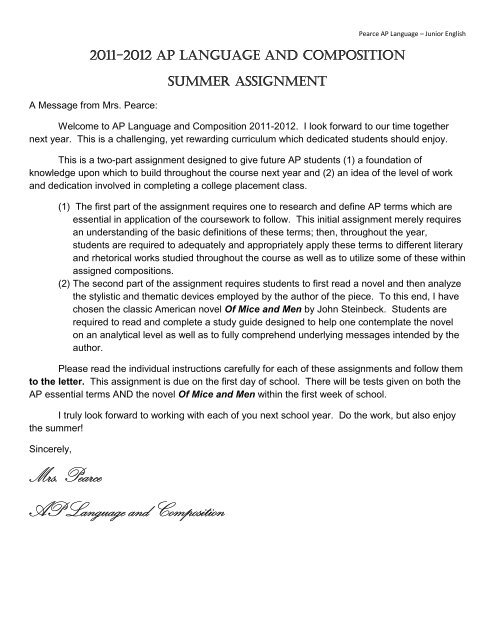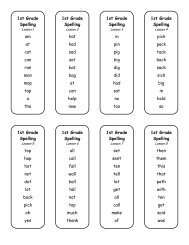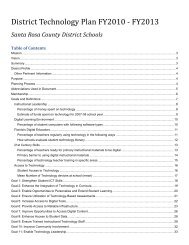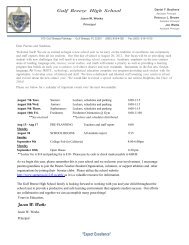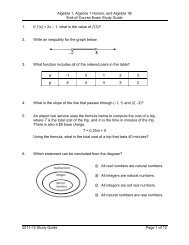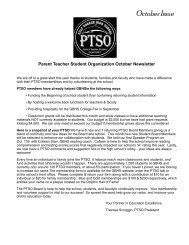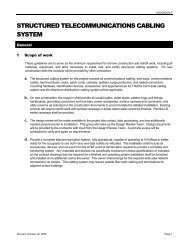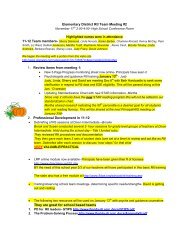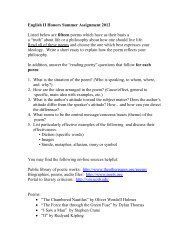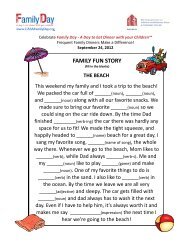Mrs. Pearce AP Language and Composition - Santa Rosa County ...
Mrs. Pearce AP Language and Composition - Santa Rosa County ...
Mrs. Pearce AP Language and Composition - Santa Rosa County ...
Create successful ePaper yourself
Turn your PDF publications into a flip-book with our unique Google optimized e-Paper software.
2011-2012 <strong>AP</strong> LANGUAGE AND COMPOSITION<br />
A Message from <strong>Mrs</strong>. <strong>Pearce</strong>:<br />
SUMMER ASSIGNMENT<br />
<strong>Pearce</strong> <strong>AP</strong> <strong>Language</strong> – Junior English<br />
Welcome to <strong>AP</strong> <strong>Language</strong> <strong>and</strong> <strong>Composition</strong> 2011-2012. I look forward to our time together<br />
next year. This is a challenging, yet rewarding curriculum which dedicated students should enjoy.<br />
This is a two-part assignment designed to give future <strong>AP</strong> students (1) a foundation of<br />
knowledge upon which to build throughout the course next year <strong>and</strong> (2) an idea of the level of work<br />
<strong>and</strong> dedication involved in completing a college placement class.<br />
(1) The first part of the assignment requires one to research <strong>and</strong> define <strong>AP</strong> terms which are<br />
essential in application of the coursework to follow. This initial assignment merely requires<br />
an underst<strong>and</strong>ing of the basic definitions of these terms; then, throughout the year,<br />
students are required to adequately <strong>and</strong> appropriately apply these terms to different literary<br />
<strong>and</strong> rhetorical works studied throughout the course as well as to utilize some of these within<br />
assigned compositions.<br />
(2) The second part of the assignment requires students to first read a novel <strong>and</strong> then analyze<br />
the stylistic <strong>and</strong> thematic devices employed by the author of the piece. To this end, I have<br />
chosen the classic American novel Of Mice <strong>and</strong> Men by John Steinbeck. Students are<br />
required to read <strong>and</strong> complete a study guide designed to help one contemplate the novel<br />
on an analytical level as well as to fully comprehend underlying messages intended by the<br />
author.<br />
Please read the individual instructions carefully for each of these assignments <strong>and</strong> follow them<br />
to the letter. This assignment is due on the first day of school. There will be tests given on both the<br />
<strong>AP</strong> essential terms AND the novel Of Mice <strong>and</strong> Men within the first week of school.<br />
I truly look forward to working with each of you next school year. Do the work, but also enjoy<br />
the summer!<br />
Sincerely,<br />
<strong>Mrs</strong>. <strong>Pearce</strong><br />
<strong>AP</strong> <strong>Language</strong> <strong>and</strong> <strong>Composition</strong>
<strong>Pearce</strong> <strong>AP</strong> <strong>Language</strong> – Junior English<br />
<strong>AP</strong> <strong>Language</strong> <strong>and</strong> <strong>Composition</strong> – Essential Terms<br />
Summer Assignment #1. Directions: Create note cards for each of the words below using 3x5 index cards (alternatively, you may type<br />
them out <strong>and</strong> cut them to size if you prefer). Neatly center the word on each card AND write the CATEGORY (the underlined words) at<br />
the top left on the word side—then write a detailed definition on the back side. You will be using these cards all year for different<br />
activities so be thorough <strong>and</strong> neat.<br />
I. Modes of Rhetoric<br />
A. expository<br />
1. classification<br />
2. cause <strong>and</strong> effect<br />
3. comparison/contrast<br />
4. definition<br />
5. analysis<br />
B. description<br />
C. narration<br />
D. persuasion/argument<br />
II. Genres<br />
A. allegory<br />
B. autobiography<br />
C. biography<br />
D. chronicle<br />
E. diary<br />
F. essay<br />
G. fiction/non-fiction<br />
H. parody<br />
I. prose<br />
J. satire<br />
K. sermon<br />
L. stream of consciousness<br />
III. Figures of Speech<br />
A. analogy<br />
B. apostrophe<br />
C. cliché<br />
D. colloquialism<br />
E. epithet<br />
F. euphemism<br />
G. hyperbole<br />
I. imagery<br />
J. irony<br />
1. verbal<br />
2. situational<br />
3. dramatic<br />
K. metaphor<br />
L. metonymy<br />
M. oxymoron<br />
N. paradox<br />
O. personification<br />
P. pun<br />
Q. simile<br />
R. synaesthesia<br />
S. synecdoche<br />
T. understatement<br />
IV. Sound devices<br />
A. alliteration<br />
B. onomatopoeia<br />
V. Diction<br />
A. connotation vs. denotation<br />
B. pedantic vs. simple<br />
C. monosyllabic vs. polysyllabic<br />
D. euphonious vs. cacophonic<br />
E. literal vs. figurative<br />
F. active vs. passive<br />
G. overstated vs. understated<br />
H. colloquial vs. formal<br />
I. non-st<strong>and</strong>ard: slang vs. jargon<br />
VI. Literary <strong>and</strong> Rhetorical Terms<br />
A. allusion<br />
B. ambiguity<br />
C. anachronism<br />
D. aphorism<br />
E. audience<br />
F. invective<br />
G. juxtaposition<br />
H. malapropism<br />
I. rhetorical question<br />
J. tone<br />
K. point of view<br />
L. style<br />
M. theme<br />
N. thesis<br />
O. voice<br />
VII. Argument/Persuasion Terms<br />
A. persuasion<br />
B. argument<br />
C. appeals<br />
1. Pathos<br />
2. Ethos<br />
3. Logos<br />
D. claim<br />
E. deductive reasoning<br />
F. inductive reasoning<br />
G. evidence/data<br />
H. warrant<br />
I. logical fallacies<br />
VIII. Tone Words<br />
A. Impartial<br />
B. Condescending<br />
C. Critical<br />
D. C<strong>and</strong>id<br />
E. Agitated<br />
F. Apathetic<br />
G. Colloquial<br />
H. Clinical<br />
I. Moralistic<br />
J. Cynical<br />
K. Didactic<br />
L. Sarcastic<br />
M. Sardonic<br />
N. Laudatory<br />
O. Hyperbolic<br />
P. Nostalgic<br />
Q. Pedantic<br />
R. Flippant<br />
S. Reverent<br />
T. Somber<br />
U. Ambivalent<br />
V. Elegiac<br />
W. Embittered<br />
X. Empathetic<br />
Y. Melancholy<br />
Z. Pedantic
<strong>Pearce</strong> <strong>AP</strong> <strong>Language</strong> – Junior English<br />
Of Mice <strong>and</strong> Men<br />
Study Guide<br />
Summer Assignment #2. Directions: CAREFULLY READ ALL DIRECTIONS! In complete sentences, thoroughly<br />
answer these study questions to the best of your ability. Complete responses are required, especially in reference to twopart<br />
questions. It is to your benefit to read the entire novel first, <strong>and</strong> then to answer the study questions by re-reading<br />
each chapter. You are welcome to research some of the themes <strong>and</strong> ideas related in this novel, however, it is imperative<br />
that you personally answer these questions in your own words. NO PLAGIARISM or COPYING will be tolerated. You<br />
may h<strong>and</strong> write OR type your responses, but be sure to properly label with the chapter <strong>and</strong> number of each response.<br />
Be prepared to turn in your responses on the first day of school <strong>and</strong> to test over the novel within the first week. It will be<br />
an essay test so you may also want to brush up on your writing skills. Happy Reading!<br />
Chapter 1<br />
1. Begin this novel by briefly researching the historic time period of “The Great Depression” in America. What<br />
was the main problem during this time period? What does the term “migrant worker” mean? Why were many<br />
men traveling from place to place?<br />
2. Next, research the author, John Steinbeck. List 5 interesting facts you discovered about this author’s life<br />
<strong>and</strong> style of writing.<br />
3. Reread the first paragraph of the novel. How does the passage function? What purpose does Steinbeck<br />
fulfill by beginning the novel in this way?<br />
4. Compare <strong>and</strong> contrast the two men who come into the clearing by the river. What do you think Steinbeck<br />
wants the reader to infer about the two men based on their descriptions?<br />
5. What information about Lennie’s character is revealed to the reader through George’s discovery of the dead<br />
mouse in Lennie’s pocket?<br />
6. As George <strong>and</strong> Lennie are waiting to go to the camp, George states, “God, you’re a lot of trouble. I could get<br />
along so easy <strong>and</strong> son nice if I didn’t have you on my tail. I could live so easy <strong>and</strong> maybe have a girl.” (p. 7) Explain<br />
what this statement illustrates about George’s feelings toward Lennie. How is George’s statement ironic given<br />
the time period in which the novel is set? What does the reader learn about George <strong>and</strong> his dreams?<br />
7. Why does Lennie like George to tell the story of the ranch, even though he already knows it by heart? Why<br />
does George so readily agree to tell the story, even though he has just gotten angry with Lennie a few minutes<br />
before? What does this story reveal about one of the themes in the novel?<br />
Chapter 2<br />
8. In this chapter, Steinbeck again begins with a description of the setting. Explain how this description is<br />
different from the description at the beginning of the previous chapter. What does this description tell us<br />
about George <strong>and</strong> Lennie’s life?
<strong>Pearce</strong> <strong>AP</strong> <strong>Language</strong> – Junior English<br />
9. In the scene between the boss, George, <strong>and</strong> Lennie that begins on page 22, how does the boss misinterpret<br />
what is going on between George <strong>and</strong> Lennie? What does the boss think is taking place? What does the reader<br />
know about the conversation between the three men?<br />
10. Explain the irony in Lennie’s last name.<br />
11. Describe the tone in the following passage. How does Steinbeck create the tone? What does it reveal about<br />
Curley?<br />
“His eyes passed over the new men <strong>and</strong> he stopped. He glanced coldly at George <strong>and</strong> then at Lennie. His arms<br />
gradually bent at the elbows <strong>and</strong> his h<strong>and</strong>s closed into fists. He stiffened <strong>and</strong> went into a slight crouch. His<br />
glance was at once calculating <strong>and</strong> pugnacious. Lennie squirmed under the look <strong>and</strong> shifted his feet nervously.<br />
“(p. 25)<br />
12. Throughout this chapter, Lennie <strong>and</strong> George are questioned three times about traveling together. Describe<br />
the three encounters <strong>and</strong> what we learn about the characters through their responses to George’s answer.<br />
Chapter 3<br />
13. What does the reader learn about the relationship between George <strong>and</strong> Lennie as George talks to Slim?<br />
14. Why does Steinbeck try to create sympathy for Lennie? Is he successful?<br />
15. Read the following passage found on page 48. This is just one of the several images of silence that<br />
Steinbeck uses:<br />
“His voice trailed off. It was silent outside. Carlson’s footsteps died away. The silence came into the room. And<br />
the silence lasted.”<br />
Why does silence play an important role at this point in the novel? Who is literally being silenced? Who is<br />
metaphorically being silenced, <strong>and</strong> what role does each man play in the silence?<br />
16. Describe the situation that occurs when Curley comes into the bunk house. What does this situation<br />
illustrate about Curley’s character <strong>and</strong> his relationship with his wife?<br />
17. After George, Lennie, <strong>and</strong> C<strong>and</strong>y make a pact not to tell anyone about their dream, C<strong>and</strong>y makes the<br />
following statement: “I ought to of shot that dog myself, George. I shouldn’t ought to of let no stranger shoot my dog”<br />
(p. 61). Explain the parallelism between the relationship C<strong>and</strong>y had with his dog <strong>and</strong> George has with Lennie.<br />
How might this statement be an example of foreshadowing?<br />
18. Explain (through specific examples in the text) the rhetorical devices Steinbeck uses in the fight scene, <strong>and</strong><br />
analyze their purpose. How do the descriptions of Curley change throughout the fight?<br />
19. Why will Curley keep quiet about what Lennie did to him <strong>and</strong> not try to get George <strong>and</strong> Lennie fired? How<br />
does this reflect on Curley’s character?
<strong>Pearce</strong> <strong>AP</strong> <strong>Language</strong> – Junior English<br />
Chapter 4<br />
20. Some of the character names are nicknames, given to describe a characteristic, such as Slim (thin) <strong>and</strong><br />
Crooks (crooked spine). Other names, however, seem to point to deeper meanings. Why do you think<br />
Steinbeck chose the following names for his characters? Use examples from the novel to articulate your<br />
opinion.<br />
Curley:<br />
Whit:<br />
C<strong>and</strong>y:<br />
21. Explain the implications of Steinbeck’s not giving Curley’s wife a name.<br />
22. How is Crook’s loneliness different from the other characters on the ranch?<br />
23. When Curley’s wife comes to Crooks’ door, how is her initial response to the men parallel to the way in<br />
which Crooks initially responds to Lennie?<br />
24. When Curley’s wife sees Lennie, C<strong>and</strong>y, <strong>and</strong> Crooks talking together, how does she characterize them?<br />
What do you think is the real reason behind her visit?<br />
25. Characterize Curley’s wife as she is presented in the novel. How is the reader supposed to feel about her?<br />
26. Why does Steinbeck diverge from his narration to focus a chapter on two different characters in the novel,<br />
Crooks <strong>and</strong> Curley’s wife?<br />
27. When Curley’s wife is asked to leave Crooks’ room, she begins to threaten Crooks. Cite examples from the<br />
imagery that indicate Crooks feels defeated.<br />
28. Dialect is a big part of this novel. Explain the following expressions from chapter four:<br />
• “They’ll take ya to the booby hatch.” (p. 72);<br />
• “…<strong>and</strong> listen how Curley’s gonna lead with his left twist, <strong>and</strong> then bring in the ol’ right cross?” (p. 78);<br />
• “What you think you’re sellin’ me?” (p. 78);<br />
• “Caught in a machine—baloney!” (p. 78);<br />
• “I could get you strung up on a tree so easy it ain’t even funny.” (p. 79).<br />
Chapter 5<br />
29. Despite the descriptive setting of the barn <strong>and</strong> the quiet Sunday afternoon, Chapter Five begins with an<br />
accident. Explain what happened <strong>and</strong> why Lennie is so worried. What are the larger implications that<br />
Steinbeck wants the reader to consider?<br />
30. How is Curley’s wife described when she comes into the barn? Why do you think Steinbeck describes her<br />
in this way?
<strong>Pearce</strong> <strong>AP</strong> <strong>Language</strong> – Junior English<br />
31. When Lennie is explaining to Curley’s wife what happened to the puppy, she responds, “Don’t you worry<br />
none. He was jus’ a mutt. You can get another one easy. The whole country is fulla mutts” (p. 87). Explain the<br />
symbolism in her statement.<br />
32. Throughout the book, the reader learns about Lennie <strong>and</strong> George’s dream. What does the reader learn<br />
about Curley’s wife’s dream? How does her dream influence her life?<br />
33. Why does Curley’s wife fail to recognize the danger in Lennie’s behavior? Why does Steinbeck portray her<br />
as almost sympathetic <strong>and</strong> comforting to Lennie?<br />
34. Why does Lennie panic, <strong>and</strong> what happens as a result of his panic? How is this similar to an event earlier<br />
in the story?<br />
35. Compare the events at the beginning of the chapter with the events that happen at the end of the chapter.<br />
36. What evidence in the novel has suggested that something tragic was going to happen to Curley’s wife?<br />
37. Explain the following description from the novel: “And the meanness <strong>and</strong> the plannings <strong>and</strong> the discontent <strong>and</strong><br />
the ache for attention were all gone from her face. She was very pretty <strong>and</strong> simple, <strong>and</strong> her face was sweet <strong>and</strong> young”<br />
(pp. 92-93). Do you think that Steinbeck is purposefully taking a misogynistic attitude toward women, or is<br />
Curley’s wife simply a representation of a woman’s life during the Depression?<br />
38. What do the men suppose happened to Carlson’s gun? Why is this hard to believe? What is the greater<br />
implication of the missing gun?<br />
39. Steinbeck could have concluded the chapter with the men headed off in search of Lennie. Instead,<br />
Steinbeck returns to the barn where C<strong>and</strong>y is staying with the dead body. Why do you think Steinbeck chose to<br />
close the chapter in this way?<br />
Chapter 6<br />
40. Compare the beginning of Chapter Six with the beginning of the novel. Explain why<br />
Steinbeck would begin this chapter in the same way that he began the first?<br />
41. What delusion does Lennie experience as he is waiting for George? Why do you think he remembers this<br />
experience?<br />
42. When George finds Lennie, what does Lennie expect him to do? How does George actually respond?<br />
43. How does the reader know that Lennie does not realize that he has done something wrong?<br />
44. How does George’s responsibility in killing Lennie parallel the situation between C<strong>and</strong>y <strong>and</strong> his dog?<br />
45. What is George trying to accomplish by shooting Lennie before the other men come to do it?<br />
46. Who ultimately underst<strong>and</strong>s what happened between Lennie <strong>and</strong> George? Why are the other men unable<br />
to underst<strong>and</strong>?<br />
47. Explain the significance of the final statement in the novel.<br />
48. Explain the significance of the title of this novel. It is from a poem by Robert Burns containing this line:<br />
“The best laid schemes o’ Mice an’ Men, gang aft agley” which loosely translates to “The best laid schemes of<br />
Mice <strong>and</strong> Men, often go awry.” How does this fit into the theme(s) of the novel?


